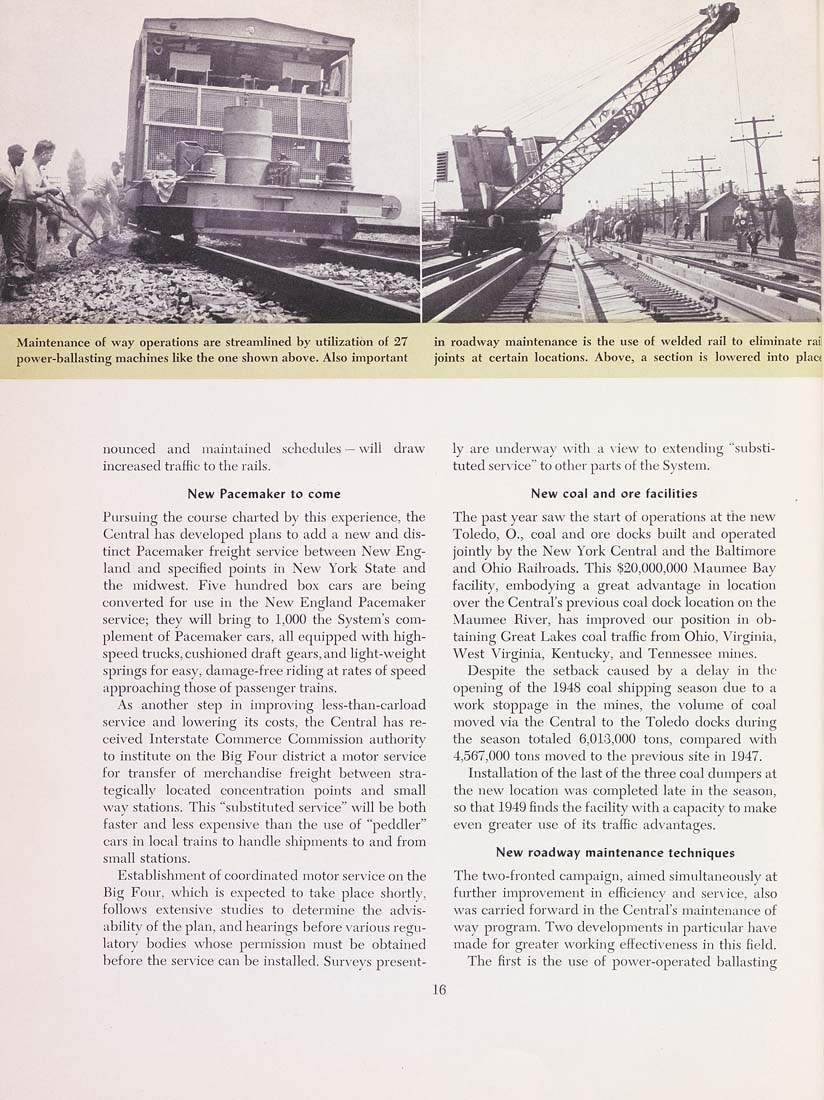'i-'-^k'^"J-..-~~:^:^\'^^' Z^''
Maintenance of way operations are streamlined by utilization of 27
power-ballasting machines like the one shown above. Also important
in roadway maintenance is the use of welded rail to eliminate rail
joints at certain locations. Above, a section is lowered into place
nounced and maintained schedules — will draw ly are undeiway with a \icw to extending "substi-
increased traffic to the i-ails, tuted scr\"ice"" to other parts of the System.
New Pacemaker to come
Pursuing the course charted by this experience, the
Central has developed plans to add a new and dis¬
tinct Pacemaker freight service between New Eng¬
land and specified points in New York State and
the midwest. Five hundred box cars are being
converted for use in the New England Pacemaker
service; they will bring to 1,000 the System's com¬
plement of Pacemaker cars, all equipped with high¬
speed trucks, cushioned draft gears,and light-weight
springs for easy, damage-free riding at rates of speed
approaching those of passenger trains.
As another step in improving less-than-carload
service and lowering its costs, the Central has re¬
ceived Interstate Commerce Commission authority
to institute on the Big Four district a motor service
for transfer of merchandise freight between stra¬
tegically located concentration points and small
way stations. This "substituted service" will be both
faster and less expensive than the use of "peddler"
cars in local trains to handle shipments to and fi'om
small stations.
Establishment of coordinated motor service on the
Big Four, which is expected to take place shortly,
follows extensive studies to determine the advis¬
ability of the plan, and hearings before various regu¬
latory bodies whose permission must be obtained
before the service can be installed. Survevs present-
New coal and ore facilities
The past year saw the start of operations at the new
Toledo, O., coal and ore docks buift and operated
jointly by the New York Central and the Baltimore
and Ohio Railroads. This $20,000,000 Maumee Bay
facility, embodying a great advantage in locatioit
over the Central's previous coal dock location on the
Maumee River, has improved our position in ob¬
taining Creat Lakes coal traffic from Ohio, Vii'ginia,
West Virginia, Kentucky, and Tennessee mines.
Despite the setback caused by a delay in the
opening of the 1948 coal shipping season due to a
work stoppage in the mines, the volume of coal
moved via the Central to the Toledo docks during
the season totaled 6,013,000 tons, compared with
4,567,000 tons moved to the previous site in 1947.
Installation of the last of the three coal dumpers at
the new location was completed late in the season,
so that 1949 finds the facility with a capacity to make
even greater use of its traffic advantages.
New roadway maintenance techniques
The two-fronted campaign, aimed simultaneously at
further improvement in efficiency and service, also
was carried forward in the Central's maintenance of
way program. Two developments in particular have
made for greater working effectiveness in this field.
The first is the use of power-operated ballasting
|








